
Five-spice powder is a spice mixture of five or more spices used predominantly in almost all branches of Chinese cuisine. The five flavors of the spices refers to the five traditional Chinese elements. The addition of eight other spices creates thirteen-spice powder (十三香), which is used less commonly.
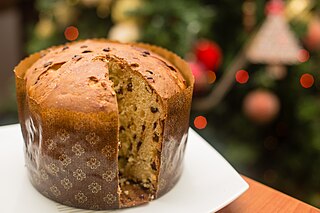
Panettone is an Italian type of sweet bread and fruitcake, originally from Milan, Italy, usually prepared and enjoyed for Christmas and New Year in Western, Southern, and Southeastern Europe, as well as in South America, Eritrea, Australia, the United States and Canada.
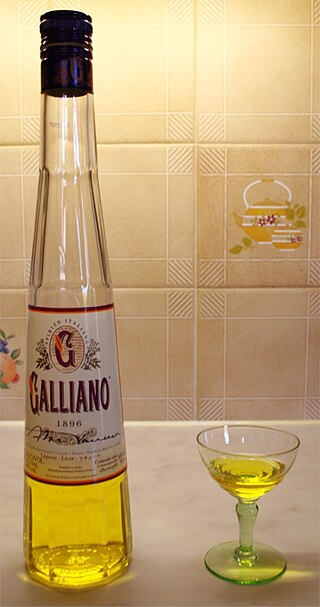
Liquore Galliano L'Autentico, known more commonly as Galliano, is a brand of sweet herbal liqueur produced in Italy. It was created in 1896 by Tuscan distiller and brandy producer Arturo Vaccari and named after Giuseppe Galliano, an Italian officer of the Royal Italian Army of the First Italo-Ethiopian War.
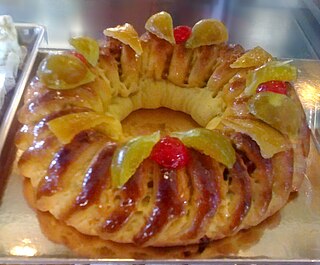
A buccellato is a Sicilian circular cake made from pastry dough filled with figs and nuts. In Sicily, it is traditionally associated with Christmas.
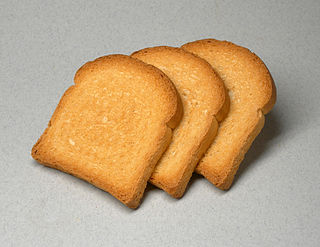
A rusk is a hard, dry biscuit or a twice-baked bread. It is sometimes used as a teether for babies. In some cultures, rusk is made of cake, rather than bread: this is sometimes referred to as cake rusk. In the UK, the name also refers to a wheat-based food additive.

Biscotti or cantucci are Italian almond biscuits that originated in the Tuscan city of Prato. They are twice-baked, oblong-shaped, dry, crunchy, and may be dipped in a drink, traditionally Vin Santo. Smaller biscotti may be aknown as known as biscottini or cantuccini.

Muisjes are aniseed comfits and are a traditional Dutch bread topping. While customary on bread, they are traditionally eaten on beschuit, or rusk. Muisjes is a registered trademark of Koninklijke De Ruijter BV. Muisjes are made of aniseeds with a sugared and colored outer layer. They are currently only produced by the Dutch food processing company De Ruijter, a brand acquired by Heinz in 2001.
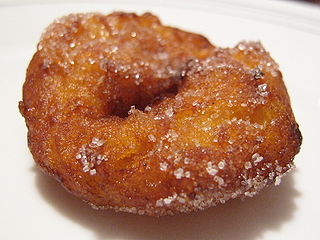
A buñuelo (Spanish:[buˈɲwelo], alternatively called boñuelo, bimuelo, birmuelo, bermuelo, bumuelo, burmuelo, or bonuelo, is a fried dough fritter found in Spain, Latin America, and other regions with a historical connection to Spaniards, including Southwest Europe, the Balkans, Anatolia, and other parts of Asia and North Africa. Buñuelos are traditionally prepared at Christmas. It will usually have a filling or a topping. In Mexican cuisine, it is often served with a syrup made with piloncillo.

In many European countries, particularly in Central and Eastern Europe, there are various traditions surrounding the use of bread during the Easter holidays. Traditionally the practice of eating Easter bread or sweetened "communion" bread traces its origin back to Byzantium, Eastern Catholicism and the Orthodox Christian church. The recipe for sweetened or "honey-leavened" bread may date back as far as the Homeric Greek period based on anecdotal evidence from classical texts.

In North America, Italian sausage most often refers to a style of pork sausage. The sausage is often noted for being seasoned with fennel or anise as the primary seasoning. In Italy, however, a wide variety of sausages are made, many of which are quite different from the aforementioned product.

Folar or folar de Páscoa is a traditional Portuguese bread served at Easter. The recipe varies from region to region and it may be sweet or savory.

Colomba pasquale or colomba di Pasqua is an Italian traditional Easter bread, the Easter counterpart of the two well-known Italian Christmas desserts, panettone and pandoro.

The cocaCoc or Fogassa is a pastry typically made and consumed in Catalonia, the Aragonese Strip, most of Valencia, the Balearic Islands, Andorra and in French Catalonia.
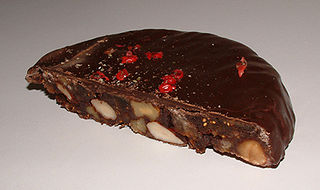
Panpepato or pampepato is a round, sweet cake typical of the province of Ferrara, Siena, the south Umbria and north of Lazio also called "pangiallo". Panpepato is a type of panforte. It is made according to traditional methods from various ingredients including fruits and nuts, such as almonds, hazelnuts, pine nuts, walnuts, pepper, cinnamon, nutmeg, and zest of orange and lime, mixed according to the variants with or without cocoa, honey, flour, or cooked grape must. The cake is then baked in an oven. After baking, it is covered with a layer of chocolate. It is usually eaten during the Christmas holidays. Once it was prepared in every family with recipes that differed slightly from each other, while today it is essentially a handmade product.
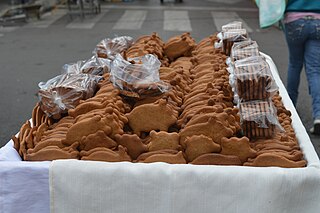
Cochinitos de piloncillo, also known as marranitos, cochinitos and puerquitos, are a typical Mexican sweet bread made with "piloncillo"—a type of sweetener made from sugar cane. Cochinitos are popular in bakeries in Mexico and throughout the US.
Guanimes are a prepared food that can be traced back to the pre-Columbian era in Puerto Rico. Guanimas translates to corn bread By the Tainos who were native Indians from Puerto Rico. They are made with cornmeal, sugar, salt all purpose flour and butter wrap in banana leaves. That is the traditional way of Guanimas. You can ad salty cod fish or holy broth that is made of coconut milk and fish That is a typical meal for Ester week. All this add raisins, plantain and stuff are not a traditional way.
Bolo, also known as Bulu, is a sweet, round bread of Sephardi Jewish origin which is commonly prepared by Tunisian Jews, Libyan Jews, and Italian Jews, among others, for the high holidays such as Rosh Hashanah and for other special occasions.

Easter in Italy is one of the country's major holidays. Easter in Italy enters Holy Week with Palm Sunday, Maundy Thursday, Good Friday and Holy Saturday, concluding with Easter Day and Easter Monday. Each day has a special significance. The Holy Weeks worthy of note in Italy are the Holy Week in Barcellona Pozzo di Gotto and the Holy Week in Ruvo di Puglia.















